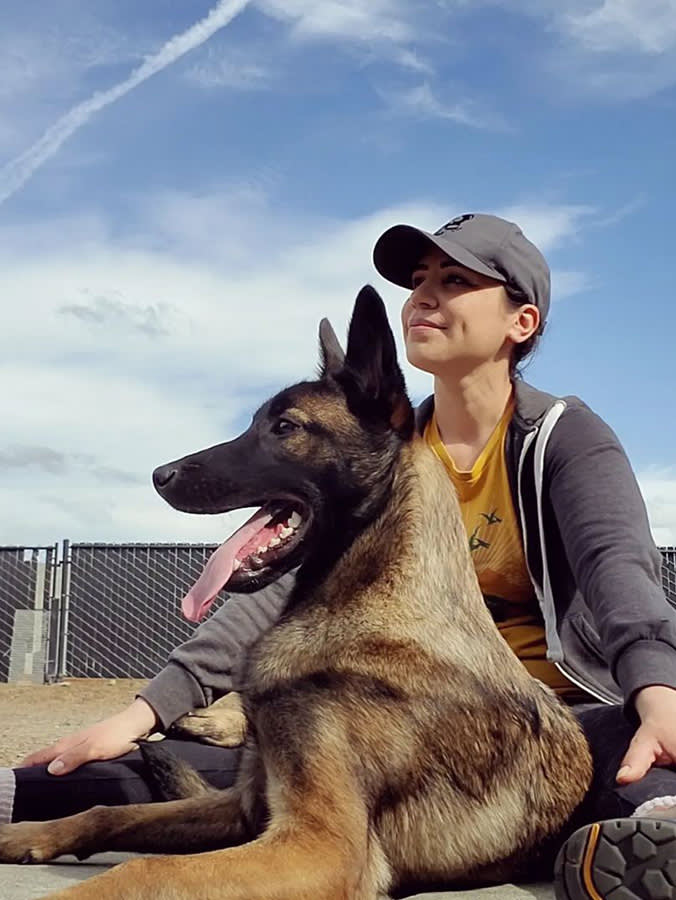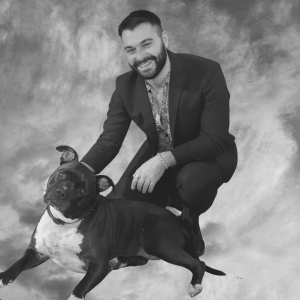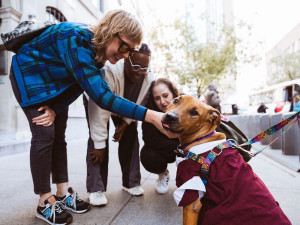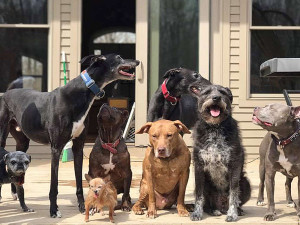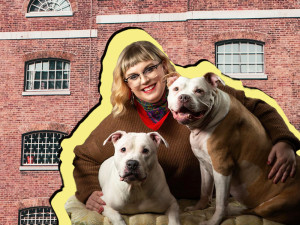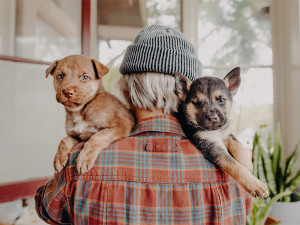The Fiction of “Unadoptable” Shelter Dogs
Wolf Mother K9 founder Saharai Salazar on misunderstood behaviors, giving every pup a chance, and the need for more empathy.
When Tom Brady was entering the NFL in 2000, nobody wanted him. This lack of interest may seem absurd now, but at the time, let’s just say teams attending his combine opens in new tab did not see the powerhouse that made Jane Fonda, Lily Tomlin, and Sally Field spend their life savings opens in new tab on Super Bowl tickets. Of course, the superstar eventually went on to win seven Super Bowls, break every passing record, cement himself as the greatest quarterback to ever live, and sentence the New York Jets to decades of irrelevance. In short, his career is proof of the old adage to never judge a book by its cover.
It’s advice that could equally apply to many dogs currently stuck in the shelter cycle, waiting for their one chance to enjoy a similarly triumphant journey.
Trick question: All dogs are perfect! But find out which type is the best fit for you.
The Biggest Rule in Rescue: Be Open-Minded
Anyone who has ever walked into an animal shelter considering adopting is likely familiar with the unpleasant sight of rows of dogs confined by kennels. As you slowly walk past each gate, you’re met with a parade of puppy dog eyes that can only be described as the Sarah McLachlan commercial incarnate.
On the way, you may also witness some animals barking loudly or showing their teeth. The instinct to assume these dogs are aggressive and opt to bring home a seemingly better-behaved one is understandable, but it’s not the most reliable one. To be clear, adopting any animal from a shelter is a noble, rewarding, and sustainable action. But these chattier pups are generally less hostile than they appear. More often than not, they’re just afraid and confused.
How much do you spend on your pet per year?
“A lot of these dogs are in cages that are six-by-three feet, essentially the size of a large closet. They don’t understand why they’re there, and all they see every day is strangers coming by in front of them. They don’t have the ability to control anything. They’re also surrounded by barking dogs all day,” says Saharai Salazar, founder of Wolf Mother K9 Rescue Servicesopens in new tab, a Santa Rosa, California-based nonprofit opens in new tab committed to reducing euthanasia and ensuring shelter dogs have every opportunity to enjoy a full life. The organization has helped rehabilitate and home countless dogs designated “unadoptable” and sentenced to euthanasia.
Salazar adds that how dogs act under these conditions isn’t always indicative of how they would act in an open and loving home. Sadly, too many never get to experience one. “[These dogs] speak from fear. A lot of dogs will growl or charge or snap at people walking by because, again, they don’t understand and they’re insecure. These dogs are scared, and they feel like everything is out of their control,” she explains.
Beyond the discomfort of being caged, these poor pooches rarely enjoy adequate sleep, thanks to the associated anxiety from their living conditions. And as someone who can’t operate a French press without a full eight hours of uninterrupted rest, I don’t think I’d fare much better. It’s a thought that Salazar agrees with — albeit in a less dramatic fashion. “We know the impact that sleep and stress have on the body, not just for ourselves but for our animal companions as well. You can only imagine the physical, emotional, and psychological toll that would take on a dog and we can’t even explain to them what’s going on,” she says.
More than anything, this hostility many dogs in shelters display is a cry for help. They are asking for relief not only from the mental anguish caused by their surroundings, but possibly for physical ailments, too. Salazar notes that a large portion of adverse reactions could have a medical component involved, as canine aggression is frequently linked to untreated lingering or chronic pain.
Even if a dog is perfectly healthy, they are generally not offered any outlet to exercise the substantial stress they face daily. Per Salazar, “When we look at all of the movement and agency our household dogs have, they’re able to walk, to eat, to drink out of their bowl of water, or play with their toys in the living room for a little bit and then move to a sunny spot to take a nap. Many of these shelter dogs do not feel sunlight, do not feel a breeze, or even touch grass for weeks or months on end.” As a result, their minds and bodies can begin to deteriorate.
The Work of Wolf Mother K9
Salazar says a common manifestation of this institutionalization is what’s called stereotype behavior or stereotypes. After being stressed 24/7 with no outlet, dogs will begin to demonstrate repetitive movements with no actionable goal. These behaviors include excessively licking the kennel or chewing drywall off of the surrounding wall. Some might continually spin in circles or chase their tail. Repetitive barking accompanied by dilated pupils is also common, further lowering dogs’ chance of adoption. Salazar adds that she’s witnessed many dogs drop to a third of their weight and endure severe hair loss under these circumstances.
It doesn’t help that adoption rates are already stymied by misconceptions regarding certain breeds or breed types, so it’s unsurprising that these dogs are regularly in long-term shelter stays. Salazar confirms that a large portion of these suffering pups are German Shepherds, Huskies, or Pit Bull-type dogs who face an uphill battle to adoption whether they show teeth or not.
Unfortunately, none of this information is top of mind when browsing an animal shelter. The average person doesn’t want to take on the perceived burden of caring for a dog who appears violent. So, they continue to sit in isolation until the shelter is forced to give up on them. That’s where Wolf Mother K9 comes in. The group is the last line of defense against pups being condemned to a lifetime behind kennel bars, or worse. When a dog is deemed too aggressive, Salazar and her team will take them out of their harsh conditions to give them the space, exercise, and attention needed to excavate that loving and goofy domesticated pet buried beneath their trauma.
Salazar and her team regularly travel to shelters to conduct behavioral analyses on dogs facing euthanization risk or who other trainers have deemed beyond help. By utilizing positive reinforcement, Wolf Mother K9 works to rehabilitate behaviorally challenged pups so that they can one day find their forever home.
While Salazar admits their work is rarely the end of a dog’s training journey, all they need is a spark. “We’re not looking for perfectionism, we’re just looking for enough improvement so that we can open up this dog to other people to work with,” she says. The team has also become adept at employing social media to save dogs on death row. Wolf Mother K9 frequently posts life-changing calls for fosters and adoption on Instagram when animals are up against tight euthanization deadlines.
Finding a Solution to a “Community Problem”
Salazar says that nearly 400,000 dogs are euthanized in America every year, but this is far from an issue that animal shelters and their ever-dwindling resources are solely responsible for. She acknowledges that these dogs are generally first abandoned or surrendered to a shelter. If it’s in response to aggressive behaviors, that’s still not on the dog — it’s their original environment that’s at fault. In Salazar’s eyes, these animals need more compassion and sympathetic understanding, along with the recognition that we failed them and not the other way around.
“For us, specifically, really looking at it through a lens of wellness and empathy has made such a huge difference,” she says. “Understanding the situation, that we as humans placed these dogs in shelters, wouldn’t exist if people were able to take adequate care of their animals.” Plainly, the circumstances of a standard animal shelter are not ideal for a pup’s training or well-being. “If we want better-behaved dogs, we should really be focusing on and looking at how we can best support them so they can feel their best. We all act our best when we feel our best,” Salazar continues.
As a nonprofit, Wolf Mother K9 operates primarily off donations and is always accepting contributions. If you want to support their mission, Salazar recommends doing it through local channels. Every shelter could use more volunteers or fosters because, as Salazar explains, they’re currently at a point where the rate of intake far exceeds the rate of adoption. “This is not a shelter problem. This is a community problem. And this is a crisis,” she says. We cannot just ignore it and expect other people to pick up that burden and find solutions by themselves.”
